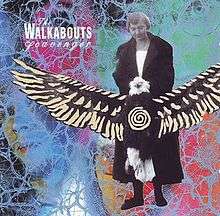Scavenger (album)
Scavenger is the fourth studio album by The Walkabouts released September 1, 1991 on Sub Pop Records.[1] It received national exposure in the United States through NPR. The album is available in various forms (CD, cassette, digital download) from Amazon.com and as digital download from iTunes Store in the US and the United Kingdom among others.
| Scavenger | ||||
|---|---|---|---|---|
 | ||||
| Studio album by | ||||
| Released | September 01, 1991 | |||
| Recorded | September/October, 1990 | |||
| Genre | Alternative rock, alternative country | |||
| Length | 42:12 | |||
| Label | Sub Pop | |||
| Producer | Gary Smith | |||
| The Walkabouts chronology | ||||
| ||||
Scavenger was produced by Gary Smith and features guest appearances by Brian Eno and Natalie Merchant.[2]
Track listing
All songs written by The Walkabouts, except where noted. All lyrics written by Chris Eckman, except where noted.
- "Dead Man Rise" – 3:27
- "Stir the Ashes" – 3:45
- "The Night Watch" – 3:28
- "Hangman" – 4:59
- "Where the Deep Water Goes" – 3:11
- "Blown Away" – 3:43
- "Nothing Is a Stranger" – 4:18
- "Let's Burn Down the Cornfield" (Randy Newman) – 2:51
- "River Blood" – 3:03
- "Train to Mercy" (string arrangement by Mark Nichols) – 9:27
The album was recorded at Steve Larsons Studios in Seattle during September and October 1990. Mixing was done in October 1990 at The Carriage House, Stanford, Connecticut. "River Blood" was remixed by Gary Smith and Matt Lane in December 1990 at The Carriage House. Additional recordings were done in the Skyline Studios, New York. The album was mastered at the Skyline Studios.
Release history[1]
| Region | Date | Label | Format | Catalog |
|---|---|---|---|---|
| United States | September 1, 1991 | Sub Pop Records | CD | SP124[4] |
| Germany | 1991 | SPCD 019/161 | ||
| LP | SP 019/161 | |||
| Glitterhouse Records | CD | GRCD 161 |
Personnel
- Glenn Slater – organ, piano, synthesizer, accordion
- Grant Eckman – drums
- Carla Torgerson – vocals, acoustic guitars, electric guitars, cello
- Michael Wells – bass
- Chris Eckman – vocals, electric guitars
- Additional musician
- Brian Eno – synthesizer, backup vocals on "Train to Mercy"
- Natalie Merchant – harmony vocals on "Where the Deep Water Goes"
- Larry Barrett – mandolin on "Where the Deep Water Goes"
- Gary Smith – tambourine on "Dead Man Rise" and "Stir the Ashes", Deepwater synthesizer on "Where the Deep Water Goes", Morricone keyboard on "Blown Way"
- Steve Haigler – sleigh bells on "Train to Mercy"
- Bravura String Quartet
strings on "Train to Mercy"
- Technical personnel
- Gary Smith – production, mixing on "River Blood"
- Ed Brooks – engineering
- Steve Haigler – mixing
- Jim Haviland – recording technician
- Bruce Calder – additional recording
- Sam Hofstedt – engineering assistant
- Matt Lane – mixing assistant, mixing on "River Blood"
- Greg Calbi – mastering
- Additional personnel
- Jane Higgins – design
- Tony Kroes – design, paintings
- Charles Peterson – color photo
- Chris Peters – paintings
Critical reception
| Review scores | |
|---|---|
| Source | Rating |
| AllMusic | |
| The Village Voice | |
| The Washington Post | (mixed)[6] |
Jason Ankeny writing in a positive review for AllMusic said: "like its predecessors, Cataract, [Scavenger] refines the Walkabouts' sound even as the band's scope broadens."[3]
References
- The Walkabouts at Discogs
- Schinder, Scott (1997). "The Walkabouts". In Ira A. Robbins (ed.). The Trouser Press Guide to 90's Rock: The All-New Fifth Edition of The Trouser Press Record Guide (5th ed.). A Fireside Book Published by Simon & Schuster. ISBN 9780684814377. Retrieved 28 May 2012.
- Jason Ankeny (1991). "Scavenger, The Walkabouts > Review". AllMusic. Retrieved 2012-05-28.
- "Sub Pop, The Walkabouts, Scavenger". Sub Pop Records. Retrieved 2012-11-13.
- Christgau, Robert (1992-01-28). "Consumer Guide Jan. 28, 1992". The Village Voice.
- Jenkins, Mark; Jenkins, Mark (1992-02-23). "Beyond Nirvana: Seattle Bands Worth Checking Out". The Washington Post. ISSN 0190-8286. Retrieved 2017-08-12.